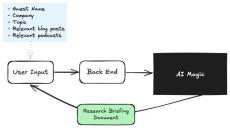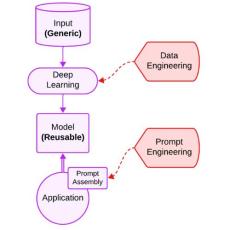|
By Kyle Moynihan
It’s a truism that global supply chains are complex. The process of sourcing raw materials, transforming them into finished products, and distributing them to customers encompasses numerous systems (e.g., ERPs, WMSs, and TMSs). All systems within “the supply chain” are trending in the same direction; they’re aiming to be more efficient, resilient, and agile. Various technological developments have facilitated this directional trend.
|
By Sean Falconer
This post was originally published on Medium on Nov. 20, 2024. The rise of agentic AI has fueled excitement around agents that autonomously perform tasks, make recommendations, and execute complex workflows blending AI with traditional computing. But creating such agents in real-world, product-driven environments presents challenges that go beyond the AI itself.
|
By Hannah Miao
As we step into the new year, it’s the perfect time to reflect on the exciting advancements Confluent made in 2024. Our Q4 launch wrapped up the year with a host of powerful features paving the way for even more innovation in 2025. This launch is all about delivering private networking and enhanced security across the data streaming platform.
|
By Sean Falconer
This article was originally published on The New Stack on Dec. 19, 2024. Imagine driving a car with a headset that only updates your view every five minutes instead of providing a continuous video stream. How long would it take before you crashed? While this type of batch processing clearly doesn’t work in the real world, it's how many systems operate today. Batch processing, born out of outdated technology constraints, forces applications to rely on static, delayed data.
|
By Adam Watkins
In building the next generation of web agents, we need the simplest, fastest way to extract web data at scale for production use cases. And for every new generative AI (GenAI) application, developers and businesses need reliable data to power the underlying models. But getting that data in a usable, trustworthy format? That’s where things get complicated.
|
By Andrew Sellers
Interest in AI has surged since 2020 and has dominated conversations across headlines and boardrooms ever since. So it’s unsurprising that business development has followed suit — 81% of IT leaders listed AI and machine learning as an important or top priority in their 2024 budgets, according to survey results in Confluent’s Data Streaming Report. But is all this attention and investment leading to a near-term future where AI is ubiquitous and functions as intended?
|
By Italo Nesi
Welcome to this three-part blog series where we explore how to transform generative AI (GenAI) into a powerful, real-time solution that drives business success.
|
By Italo Nesi
In Part I of this blog series, we laid the foundation for understanding how data fuels AI and why having the right data at the right time is essential for success. We explored the basics of AI, including its reliance on structured and unstructured data, and how streaming data can help unlock its full potential.
|
By Italo Nesi
In this final part of our blog series, we bring everything together to unlock the full potential of AI with real-time data streaming and event-driven architecture (EDA). In Part I, we explored how data fuels AI, laying the foundation for understanding AI’s reliance on fresh, relevant information.
|
By Confluent Staff
Integrating OpenAI with BigQuery unlocks powerful possibilities for AI-powered data analysis and advanced insight generation. This guide explores how the OpenAI BigQuery integration enables businesses to transform their data warehouses into intelligent analytics powerhouses.
|
By Confluent
A short live demo on how to easily migrate from Zookeeper to Kraft with Confluent for Kubernetes (CFK) in 4 simple steps.
|
By Confluent
Producer retries in Apache Kafka can make or break message delivery, especially during broker events like updates or failures. Use the idempotent producer, and configure delivery timeouts, in order to avoid common pitfalls that lead to lost messages or broken ordering.
|
By Confluent
Picking the wrong partition key in Apache Kafka? That’s a fast track to performance headaches—think unbalanced loads, slowdowns, and broken message ordering. Choosing the right partitioning strategy keeps your data flowing smoothly and avoids hot partitions.
|
By Confluent
Constantly starting and stopping Apache Kafka producers and consumers? That’s a recipe for high resource usage and inefficiency. Short-lived connections are heavy on resources, and can slow down your whole cluster. Keep them running to boost performance, cut latency, and get the most out of your Kafka setup.
|
By Confluent
Default settings in Apache Kafka work when you’re getting started, but aren't suited for production. Sticking with defaults, like a seven-day retention policy, or a replication factor of one, can cause storage issues, or data loss in case of failure. Learn why optimizing retention periods, replication factors, and partitions, is crucial for better Kafka performance and reliability.
|
By Confluent
Keeping your Apache Kafka clients up-to-date is critical for maximizing performance, security, and stability. In this video, we discuss why sticking with old versions could be putting you at risk, since it means you’re missing out on dozens of new features, and hundreds of bug fixes and security patches. Learn why upgrading is more than just a “nice-to-have”—it’s essential for a smoother and safer Kafka experience.
|
By Confluent
Setting up network connections can often seem difficult or time consuming. This video provides a wayfinding introduction to help you get networking up and running for all cluster types on Confluent Cloud, showing you your networking options for each cluster type when running on AWS, Azure, or Google Cloud, respectively.
|
By Confluent
In this short video, a Confluent Solutions Engineering will run through the high-level steps on how to get started with your migration. And even better, once you’re done watching, you can download our comprehensive migration kit for a step by step guide of everything I’ve talked about and more.
|
By Confluent
Kafka Connectors provide a way to get data flowing between your sources and sinks, and Confluent Cloud. This video reviews your options and shows you how to get started quickly.
|
By Confluent
This video provides a tour of the main Confluent Cloud interface, and shows you how to set up your first cluster.
|
By Confluent
Traditional messaging middleware like Message Queues (MQs), Enterprise Service Buses (ESBs), and Extract, Transform and Load (ETL) tools have been widely used for decades to handle message distribution and inter-service communication across distributed applications. However, they can no longer keep up with the needs of modern applications across hybrid and multi cloud environments for asynchronicity, heterogeneous datasets and high volume throughput.
|
By Confluent
Why a data mesh? Predicated on delivering data as a first-class product, data mesh focuses on making it easy to publish and access important data across your organization. An event-driven data mesh combines the scale and performance of data in motion with product-focused rigor and self-service capabilities, putting data at the front and center of both operational and analytical use-cases.
|
By Confluent
When it comes to fraud detection in financial services, streaming data with Confluent enables you to build the right intelligence-as early as possible-for precise and predictive responses. Learn how Confluent's event-driven architecture and streaming pipelines deliver a continuous flow of data, aggregated from wherever it resides in your enterprise, to whichever application or team needs to see it. Enrich each interaction, each transaction, and each anomaly with real-time context so your fraud detection systems have the intelligence to get ahead.
|
By Confluent
Many forces affect software today: larger datasets, geographical disparities, complex company structures, and the growing need to be fast and nimble in the face of change. Proven approaches such as service-oriented (SOA) and event-driven architectures (EDA) are joined by newer techniques such as microservices, reactive architectures, DevOps, and stream processing. Many of these patterns are successful by themselves, but as this practical ebook demonstrates, they provide a more holistic and compelling approach when applied together.
|
By Confluent
Data pipelines do much of the heavy lifting in organizations for integrating, transforming, and preparing data for subsequent use in data warehouses for analytical use cases. Despite being critical to the data value stream, data pipelines fundamentally haven't evolved in the last few decades. These legacy pipelines are holding organizations back from really getting value out of their data as real-time streaming becomes essential.
|
By Confluent
In today's fast-paced business world, relying on outdated data can prove to be an expensive mistake. To maintain a competitive edge, it's crucial to have accurate real-time data that reflects the status quo of your business processes. With real-time data streaming, you can make informed decisions and drive value at a moment's notice. So, why would you settle for being simply data-driven when you can take your business to the next level with real-time data insights??
|
By Confluent
Data pipelines do much of the heavy lifting in organizations for integrating and transforming and preparing the data for subsequent use in downstream systems for operational use cases. Despite being critical to the data value stream, data pipelines fundamentally haven't evolved in the last few decades. These legacy pipelines are holding organizations back from really getting value out of their data as real-time streaming becomes essential.
|
By Confluent
Shoe retail titan NewLimits relies on a jumble of homegrown ETL pipelines and batch-based data systems. As a result, sluggish and inefficient data transfers are frustrating internal teams and holding back the company's development velocity and data quality.
- January 2025 (6)
- December 2024 (24)
- November 2024 (10)
- October 2024 (24)
- September 2024 (27)
- August 2024 (15)
- July 2024 (9)
- June 2024 (22)
- May 2024 (18)
- April 2024 (7)
- March 2024 (18)
- February 2024 (13)
- January 2024 (6)
- December 2023 (9)
- November 2023 (10)
- October 2023 (14)
- September 2023 (28)
- August 2023 (8)
- July 2023 (2)
Connect and process all of your data in real time with a cloud-native and complete data streaming platform available everywhere you need it.
Data streaming enables businesses to continuously process their data in real time for improved workflows, more automation, and superior, digital customer experiences. Confluent helps you operationalize and scale all your data streaming projects so you never lose focus on your core business.
Confluent Is So Much More Than Kafka:
- Cloud Native: 10x Apache Kafka® service powered by the Kora Engine.
- Complete: A complete, enterprise-grade data streaming platform.
- Everywhere: Availability everywhere your data and applications reside.
Apache Kafka® Reinvented for the Data Streaming Era






















